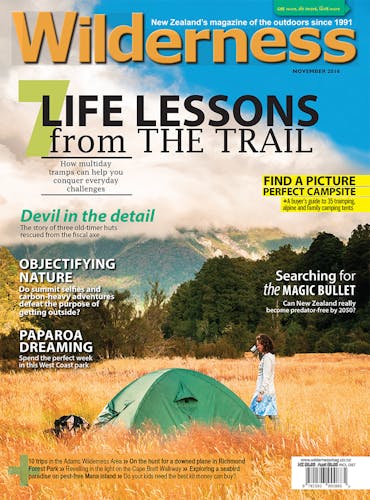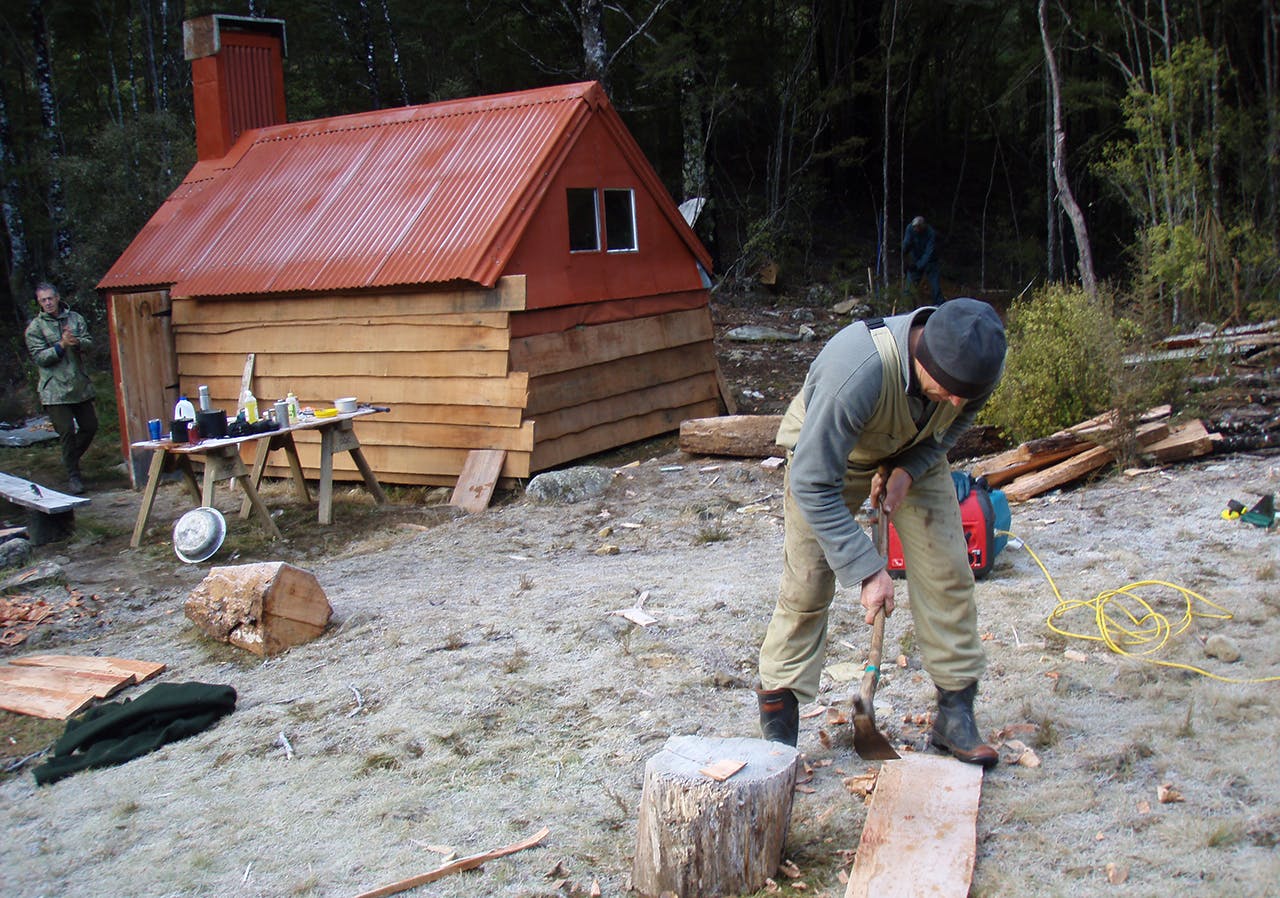How three old-timer huts were saved from the fiscal axe
Not so long ago, the old huts of Kahurangi National Park wore the weariness of decades; their timbers were gaping; floors, rotten. One was leaning like a miner on moonshine.
Now they are standing strong. But the new, exterior timber cladding bears the random cuts of hand-wielded tools. The corrugated iron roofs are rusty; the fireplaces look newly made and 100 years old; they still breathe woodsmoke and hunters’ tales.
It seems a bush-builder has stepped in from the 1930s because there is no sign of a modern restoration – no perfectly machined edges, no barcode from a hardware store. The work is new; the skills are old.
Here, a bush-builder describes how to clad a hut the old way: “Look for a tree, about two-foot diameter – you want it nice and straight. Cut it into sections one-point-two metres and drive axes into it and split it open. Hopefully it splits nice and straight, and then split it into pie sections and keep working around so you end up with a board about five-centimetres thick along one edge and one-centimetre the other. Then you trim them up slowly so they end up without high spots or low spots.
“Then you need to lay each over the piece beneath and scribe it to make sure it fits neatly and lap the whole length. Finally you nail it in place.”
This is Wayne Sixtus, president of the Golden Bay Deerstalkers Association and one of several to learn old skills in hut restoration. In his case, Chaffey Hut in the Cobb Valley.
Sixtus was inspired by the work of DOC ranger John Taylor and Max Polglaze, a ranger with NZFS from the 1960s to the 1980s. They pioneered the work on the Waingaro Forks-Anatoki Forks Track, now named the Historic Kill Devil Pack Track in Kahurangi National Park. It is a three- to five-day tramp, suitable for fit, experienced trampers. Its three old-timers – Tin Hut (1896), Riordans Hut (1926) and Waingaro Forks Hut (early 1930s) – have recently dodged the fiscal axe.
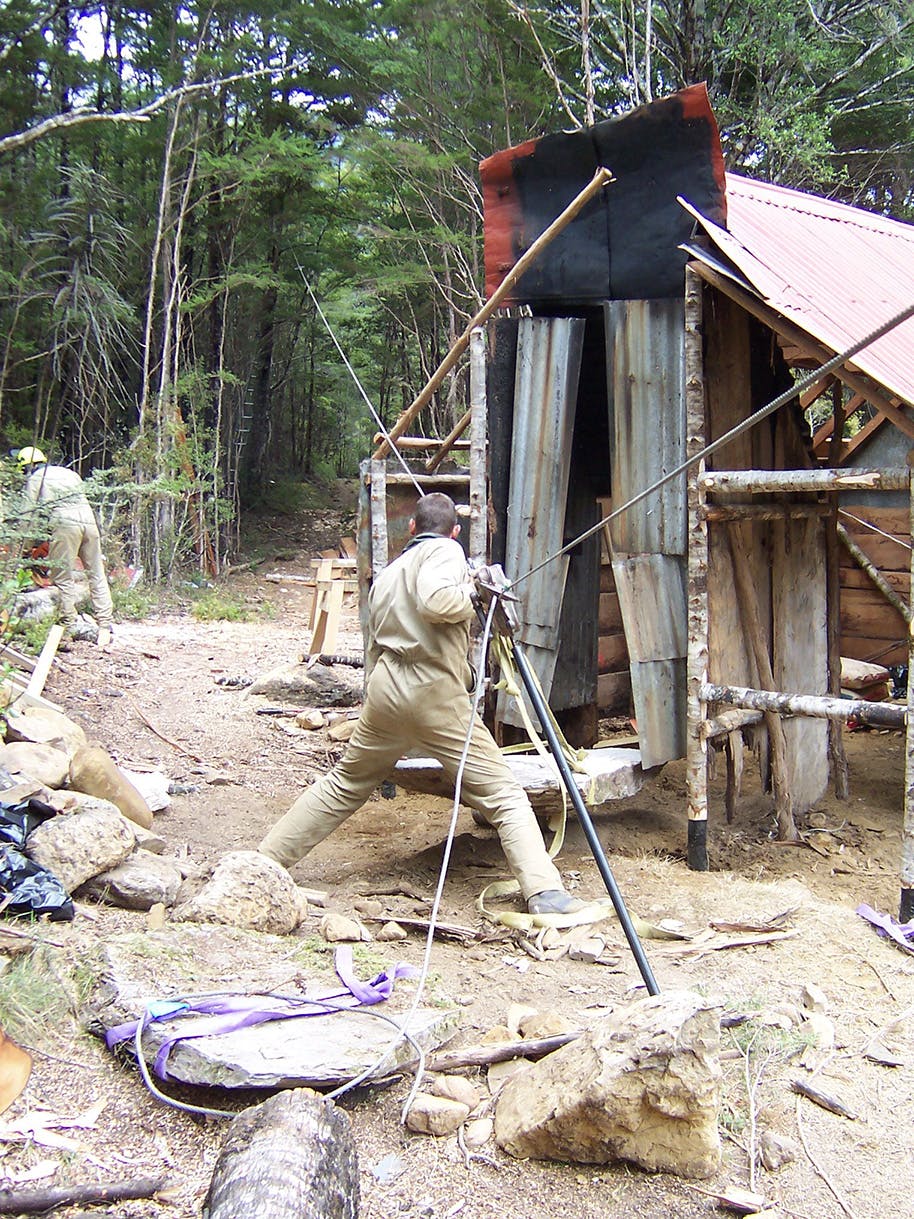
Rebuilding the hearth at Waingaro Forks hut required some heavy lifting. Photo: John Taylor
It started with Riordans Hut, about four hours in from Uruwhenua, Golden Bay. Fred Riordan built it as a musterers’ hut in the Kill Devil Range in 1926. The track leads to the Salisbury Valley, grazed by the Salisbury family from 1875 to the 1930s. Gold miners had come here in the 1890s and built the pack track; they returned with the Great Depression of the 1930s, and Fred Riordan used the track to supply them with the hut as a base.
It was simple: three bunks, a fireplace and open space outside in which to work or butcher stock for the gold miners. As the decades passed, the miners left. Riordans Hut was popular with trampers but barely maintained.
“It was damn near derelict,” John Taylor says.
Restoration was unlikely – partly because it was assumed no one had the skills for the job. More likely was that Riordans Hut would be demolished and replaced by a standard DOC four-bunk hut – prefabricated, flown in by helicopter, assembled on site for around $80,000. It would have been a soulless anomaly among the rustic huts, old fences and gold workings of the historic track.
“On your own, a modern hut can be a lonely place,” Taylor says, “but you’re never lonely in one of the old huts. You’ve always got a bit of interaction with the fireplace and a billy to swing. The glow of the fire lights up the whole place, and there’s a warm, natural, cosy feel about it.”
Max Polglaze thought so too. “He’d spent four or five days up there at Riordans and pencilled us a letter in which he made a really strong case for retaining that hut and renovating it,” Taylor says. “It was like yee-ha – just what we needed.”
The deal was done. Polglaze and Taylor restored Riordans over eight weeks, working in two-week stints.
“The whole hut was leaning downhill, heading for ground zero,” Taylor says, “so we had to straighten the thing up, give it structural integrity and brace it up.”
Fred Riordan had built the hut in split cedar laid vertically, board-and-batten style over totara and cedar poles. Someone had added a lean-to in the 1950s but its sap beech timber had rotted.
Lesson learned, Polglaze and Taylor avoided beech and used only cedar and totara. As per DOC rules, they could use only timber that was dead-standing or on the ground – no trees could be felled in the restoring of the hut. Some dead-standing trees were rotten; some moss-covered logs on the ground were sound.
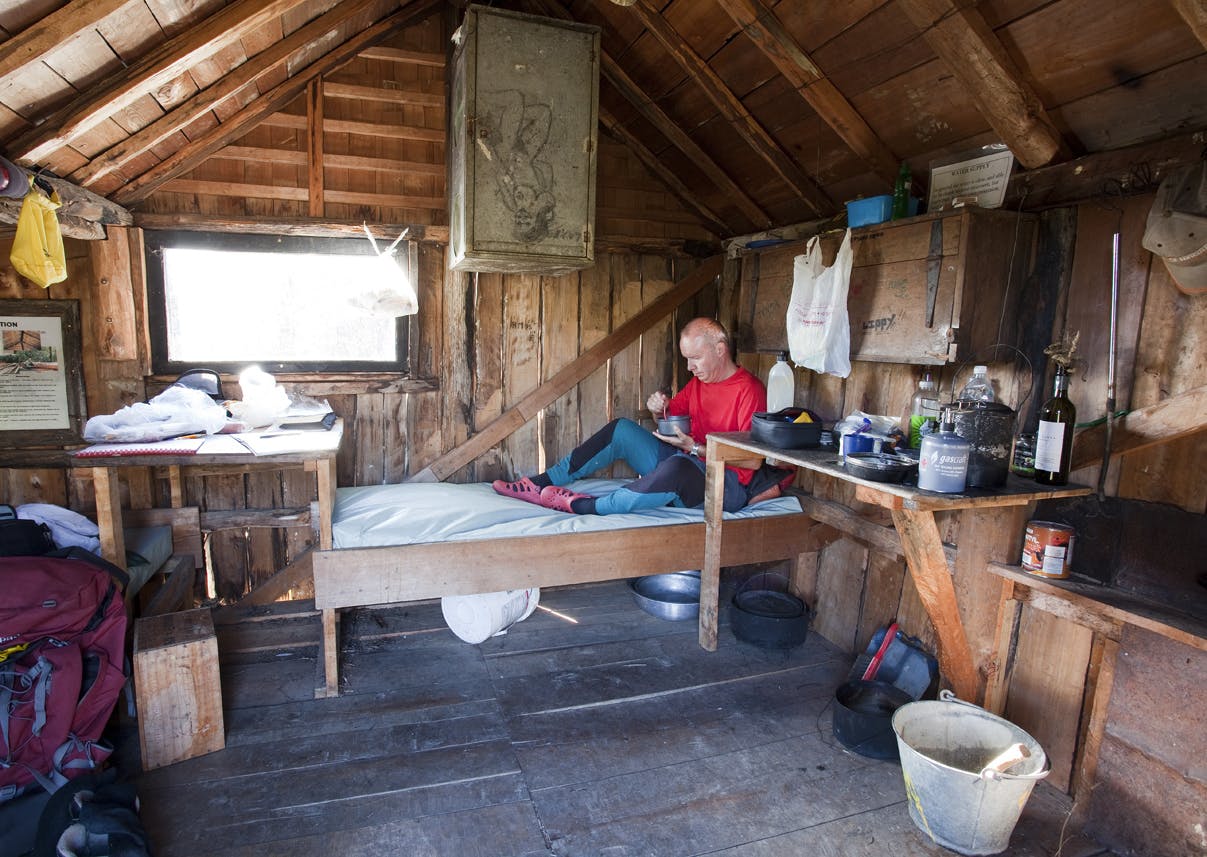
A tramper soaks in the atmosphere of the restored Riordans Hut – the first on the track to get an upgrade. Photo: Ray Salisbury
Polglaze showed Taylor how to split and slab the timber, dressing it with axes and adzes. For finishing they used draw knives – a long blade with two curvy handles like a large spokeshave. A froe was used to split cedar shingles for cladding the gable end. About one-third of the original cladding was good enough to re-use.
“The fireplace was totally buggered,” Taylor says. Polglaze built another in a century-old style using rocks and clay from the other side of the mountain.
“It’s Fred Flintstone stuff – setting up skylines and rigging and cables and hoisting and winching, with rollers and levers,” says Taylor. “Max has some pretty innovative ways of doing things.”
The cedar slats in the original floor had rotted where they’d touched the ground. Taylor and Polglaze dug out beneath the hut and fitted floor joists so the new floor would stay dry and resist rot.
The finished restoration cost about $12,000, a big saving on the standard DOC hut, but the real surprise was the gratitude from trampers and hunters. Their response inspired DOC to designate the Kill Devil Track and its huts as an actively managed historic site. This ensured funding for further restorations and a prescription to stick to historic integrity.
“That meant that if the original mantelpiece was in cedar to certain dimensions, its replacement had to be in cedar to the same dimensions,” Taylor says.
For health and safety regulations, every hut still needs a garish green and white exit sign above the door. “Don’t get me started,” Taylor says.
The next restoration, in 2006, was Tin Hut, about an hour before Riordans Hut. Tin Hut is the oldest at 120 this year and most basic: one room of corrugated iron sides and roof, no bunks, on a rock platform. Taylor led a DOC team which replaced timber framing and added adzed flooring and fixtures, and rust-treated the roof.
A bigger project, also led by Taylor, was Waingaro Forks Hut, about eight hours in from the road end at Uruwhenua. The hut has one room, four bunks, desk and fireplace; it’s clad in pit-sawn beech. Traditionally, a pit-saw involved winching or leveraging a log vertically over a pit; a man at the top worked with another in the pit, pulling a long saw up and down to mill the log lengthways.
There are limits to authenticity. In 2008, a pitsaw looked a lot like a chainsaw set-up for milling but it left similar marks on the timber.
The original beech cladding on Waingaro Forks Hut was barely hanging on but its interior side carried graffiti: names from the Depression years in the 1930s, boasts of deer tallies in the 1960s – an integral part of the hut’s story.
The solution was to put battens over the outer cladding and nail new cladding to that, leaving the graffiti intact.
The floor was beech planks, 400mm wide. Most were still usable but those around the fireplace had rotted due to condensation beneath a sheet metal hearth added in the 1990s. Although they were flat on top, they proved to be slabs, not boards, adding to their strength and stability. They were probably the first cuts off the log. The restorers replaced them like for like, with the first slabs milled.
As with every hut, the fireplace needed replacing. “We hoisted some pretty heavy slabs of rock shale from the gully and winched them to the hut,” Taylor says. “We used Max’s technique with the skyline.”
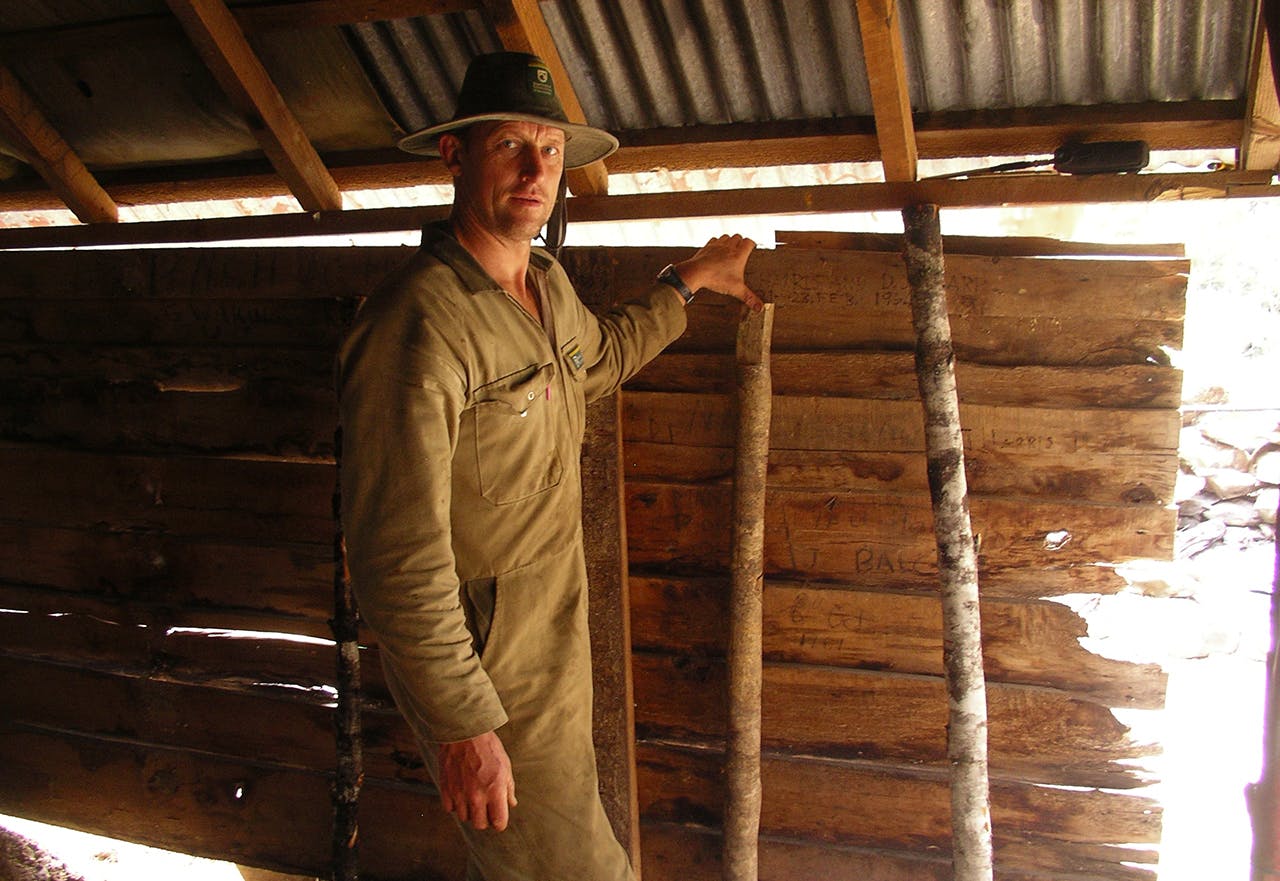
Graffiti on the inside wall of Waingaro Forks Hut’s was kept intact. Photo: John Taylor
With no heavy machinery, it was a massive amount of work but the builders loved the experience.
“It’s pretty neat having a structure that hasn’t got a whole heap of imported and manufactured materials apart from the corrugated iron roof,” Taylor says. “The old fellas couldn’t bring many materials in. They had a look around and said, ‘We’ve got good rocks, good clay, good timber and we’ll build our hut.’ So when you’re restoring those old huts you just look around and those materials will be nearby.”
He was “dead keen” to replace the roof with shingles, in keeping with most huts built in the 1920s and 1930s, but shingles don’t last and most huts later acquired roofs of corrugated iron. Logic prevailed.
By this stage, Taylor had Chaffey Hut in the Cobb Valley in his sights. Built by NZFS ranger Jack McBurney in 1953 as one room and an entrance room, three bunks in total, Chaffey Hut looks over the Cobb River as it winds down the valley. It’s cute as can be but, just two hours in from the road end, it was considered dispensable.
“But every time I went past it, I admired it, loved it and read the hut book full of passionate pleas to restore the hut,” Taylor says.
Chaffey represented yet another cladding style, using split wedges nailed or lashed to a framework of beech poles, known as pole birch, and Taylor needed to practice the technique. A new woodshed for Waingaro Forks Hut was the perfect opportunity.
Having learned the skills from Polglaze, Taylor demonstrated the techniques to Wayne Sixtus who led a team from the Golden Bay Deerstalkers Association to restore Chaffey Hut in 2012.





